MULTIPLE METHODS OF MULTIPLICATIONIn school we are taught one standard algorithm for multiplication. It looks like this: 247 ×123 741 494 247 30381 There are actually many more ways to multiply. Here are a few from different times in history and different parts of the world: ancient India, ancient Egypt, and renaissance Scotland. Try using these methods on a couple of mutiplication problems--you may find a method you like better than our usual one! How to multiply like an Egyptian
Multiply like an Egyptian 53×72
Why does this work?You can write: 53 = 1 + 4 + 16 + 32Now multiply: 53×72 = (1 + 4 + 16 + 32)x72This is the same as 1×72 + 4×72 + 16×72 + 32×72 = 72 + 288 + 1152 + 2304 = 3816 
John Napier was a Scottish baron, Laird of Merchiston, inventor, and mathematician. Logarithms ("for the more easie working of questions in arithmetike and geometrie") are his most famous contribution to math. Nearing the end of his life, John Napier, also developed an ingenious arithmetic trick - not as remarkable as logs, but very useful all the same. His invention was a method for performing arithmetic operations by the manipulation of rods, (also called ďbonesĒ because they were often constituted from ivory) and printed with digits. Napierís rods essentially rendered the complex processes of multiplication and division into the comparatively simple tasks of addition and subtraction.
The other three sides of this rod had multiples of other digits. Note that, except
for the top square, each square is divided by a diagonal, and when the digit 4
is multplied by 3 the resulting 12 is written with the 1 above a diagonal and the
2 below. All two digit numbers appear on the rods in the same way with the 10s
digit above the diagonal and the unit digit below. So, each "bone" is a list of the first nine multiples of a number between 1 and 9. There is an index "bone" for reference. Glaisher, in an article in Encyclopaedia Britannica, described the way that the numbers were placed on each of the four sides of the ten rods:-
Let's see how the rods were used... To multiply 4x759 using the bones, line up the 7, 5, and 9 bones. Put the index bone next to them. Look at the 4 row only.
Add the numbers in the diamonds. You get 2 in the 1000's place, 8 + 2 = 10 in the 100's place, and 6 in the 1's place.
Answer: 2000 + 1000 + 30 + 6 = 3036. What if you want to multiply a number by a two digit number, such as 64×759?
Multiply 4×759 as shown above. Multiply 6×759. Use the same bones but look at the 6 row. 
Multiplying 64×759 is the same as multiplying 60×759 + 4×759. Multiply 4554 by 10 and add it to 4×759=3036. 64×759=3036 + 45540 = 48576. For example to multiply 4138 by 567 place
four rods with the digits 4, 1, 3, 8 on top as shown alongside a strip containing
the numbers 1 to 9 in squares 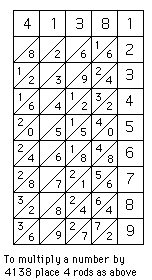 To multiply 4138 by 567 we now examine rows 5, 6 and 7 of the four rods (as indicated by the right hand strip). Looking at row 5, starting from the right, we write down the number obtained by adding the digits in the parallellograms as shown.
Next do the same with row 6, this time noting that we have to carry 1 when we add 8 + 4.
Place the numbers so that the second starts one place to the right of the first as shown
Now do the same with row 7, again placing the result one place further to the right
We now add the three numbers
We obtain the product of 4138 and 567 is 2346246. Now this may not seem a great saving in effort but, as we mentioned above, only addition is needed to carry out calculations. Napier's rods became quite popular and we used in Britain and on the Continent. The Rabdologia was translated into Italian and Dutch, and the original Latin text was republished in Leiden. We have used the name 'Napier's rods' in this article, but often the calculating aid was called 'Napier's bones'. The name comes from the title of a work by William Leybourne publiahed in 1667 entitled The art of numbering by speaking rods: vulgarly termed Napier's bones. Why did Leybourne use the term 'speaking rods'? This was simply a mistranslation of Napier's Rabdologia. This comes from 'rabdos' meaning a 'rod' and 'logia' meaning 'collection'. However Leybourne thought it came from 'rabdos' meaning a 'rod' and 'logos' meaning 'word'. Let us note that Napier also designed "square root rods" and "cube root rods" but these did not become so popular. Often Napier's rods would come in a box which contained other tables and aids for calculation. For example one set made in 1679 came in a box 12 cms by 6.4 cms by 2.8 cms. The box had a hinged lid which had, on the outside, a table giving the interest at 6 per cent for one, two, three, six, and twelve months, for each £10 from 10 to 90, and for hundreds of pounds to £500. The bottom of the box had two tables on it, one giving the year, week day, age of the moon on 1 January for 1679 to 1693, and a "Perpetual Almanac" with the year beginning in March. The second table gave the time of high tide at various places relative to the age of the moon. Inside the lid of the box is a table for addition in 13 columns of eleven numbers, the first numbered downwards from 1 to 10, the next from 1 to 11 and so on to the thirteenth numbered from 12 to 22.
One version of Napierís rods is displayed in the picture below:
The rods were extremely popular in Napierís day and oddly, they constituted the Scottish mathematicianís chief claim to glory among his contemporaries. It is indicative of the poor knowledge of arithmetic at the time, that extensive use was made of Napierís rods all over Europe, since even the simplest arithmetic operations were beyond the reach of most peopleís abilities. Thus, the rods circulated widely in basic, middling and deluxe versions. An expensive edition was also available, in which the rods were made out of ivory and they came in a carrying case of fine leather, with an addition table attached to the lid, which was included for good measure. Later on, the rods were replaced by cylinders (in which case all the rods from 0 to 9 were displayed on each cylinder) and fitted into wooden boxes. Instead of placing the rods on a board equipped with a vertical index labeled from 1 to 9, all you had to do was to rotate them in their places in the box. Napierís invention was employed extensively by people whose work depended on calculations and numbers, such as accountants, bookkeepers etc. The value of Napierís rods is exemplified by the fact that they were still being used in primary schools in Britain in the mid-1960s to assist in teaching multiplication. LogarithmsNapier's discussion of logarithms appears in Mirifici logarithmorum canonis descriptio in 1614. Two years later an English translation of Napier's original Latin text was published, translated by Edward Wright. In the preface of the book Napier explains his thinking behind his great discovery (we quote from the English translation of 1616 of the original Latin of 1614):
Unlike the logarithms used today, Napier's logarithms are not really to any base although in our present terminology it is not unreasonable (but perhaps a little misleading) to say that they are to base 1/e. Certainly they involve a constant 107 which arose from the construction in a way that we will now explain. Napier did not think of logarithms in an algebraic way, in fact algebra was not well enough developed in Napier's time to make this a realistic approach. Rather he thought by dynamical analogy. Consider two lines AB of fixed length and A'X of infinite length. Points C and C' begin moving simultaneously to the right, starting at A and A' respectively with the same initial velocity; C' moves with uniform velocity and C with a velocity which is equal to the distance CB. Napier defined A'C' (= y) as the logarithm of BC (= x), that is
Napier chose the length AB to be 107, based on the fact that the best tables of sines available to him were given to seven decimal places and he thought of the argument x as being of the form 102.sin X. At first, Napier called logarithms "artificial numbers" and antilogarithms "natural numbers". Later, Napier formed the word logarithm to mean a number that indicates a ratio: logos meaning proportion, and arithmos meaning number. Napier chose that because the difference of two logarithms determines the ratio of the numbers for which they stand, so that an arithmetic series of logarithms corresponds to a geometric series of numbers. The term antilogarithm was introduced in the late 17th century and, while never used extensively in mathematics, persisted in collections of tables until they fell into disuse. Napier did not use a base as we now understand it, but his logarithms were, up to a scaling factor, effectively to base 1/e. For interpolation purposes and ease of calculation, it is useful to make the ratio r in the geometric series close to 1. Napier chose r = 1 - 10-7 = 0.999999. Napier's original logarithms did not have log 1 = 0 but rather log 107 = 0. Thus if N is a number and L is its logarithm as calculated by Napier, N = 107(1 - 10-7)L. Since (1 - 10-7)107 is approximately 1/e, this makes L/107 approximately equal to log1/e N/107. The fact that Nap.log 1 does not equal 0 is a major difficulty which make Nap.logs much less convenient for calculations than our logs. A change to logs with log 1 = 0 came about in discussions between Napier and another mathematician, Briggs who read Napier's 1614 Latin text and, on the 10 March 1615 wrote in a letter to a friend:
In fact Briggs did make the difficult journey from London to Edinburgh to see Napier in the summer of 1615 (would he have dreamed that now it takes 4 hours by train, rather than at least 4 days by horse and coach in those times). A description of their meeting was told by John Marr to William Lilly who writes the following :
Briggs had suggested to Napier in a letter sent before their meeting that logs should be (in our terminology) to base 10 and Briggs had begun to construct tables. Napier replied that he had the same idea but :-
At their meeting Napier suggested to Briggs the new tables should be constructed with base 10 and with log 1 = 0, and indeed Briggs did construct such tables. In fact Briggs spent a month with Napier on his first visit of 1615, made a second journey from London to Edinburgh to visit Napier again in 1616 and would have made yet a third visit the following year but Napier died in the spring before the planned summer visit. How to find the logarithm of a number, using four figure log tables (below)To find the log of a number, you first need the two parts of the answer - the index or characteristic (the part before the decimal point) and the mantissa (the decimal part after the decimal point). For example, the index of 2.6742 is 2 and the mantissa is .6742. Finding the index of a logarithmThis is easy if you follow these rules: For Example:To find log 45, follow down the numbers on the far left of the table until you reach 45. The number in the column headed 0 will be the mantissa - the index is 1 (see above) - so log 45 = 1.6532. To find log 456, follow down the numbers on the far left of the table until you reach 45 and take the number in column 6. The index is 2, so log 456 = 2.6590. Using the Mean Difference Column for numbers with four digitsFor numbers with four digits, simply add the number in the mean difference column (right hand 9 columns) to the answer you would get if you just ignored the fourth digit. For Example:To find log 4567, take the log of 456 (2.6590) and add the number in column 7 of the mean differences (7) to the mantissa. ie. log 4567 = 3.6590 + 0.0007 = 3.6597. Finding logs of numbers smaller than oneThis is simple - just find the log of the four significant figures of the number, and and take away the index. For Example:To find the log of 0.004567, take log 4.567 = 0.6597 and subtract 3 (the index). So log 0.004567 = (log 4.567) - 3 = -2.3403. 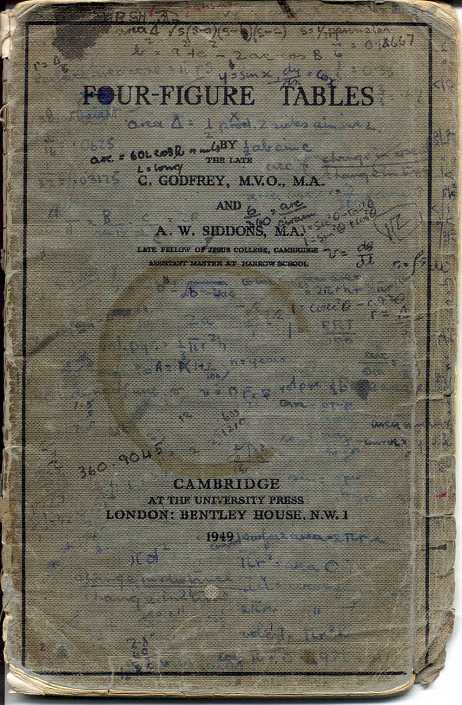
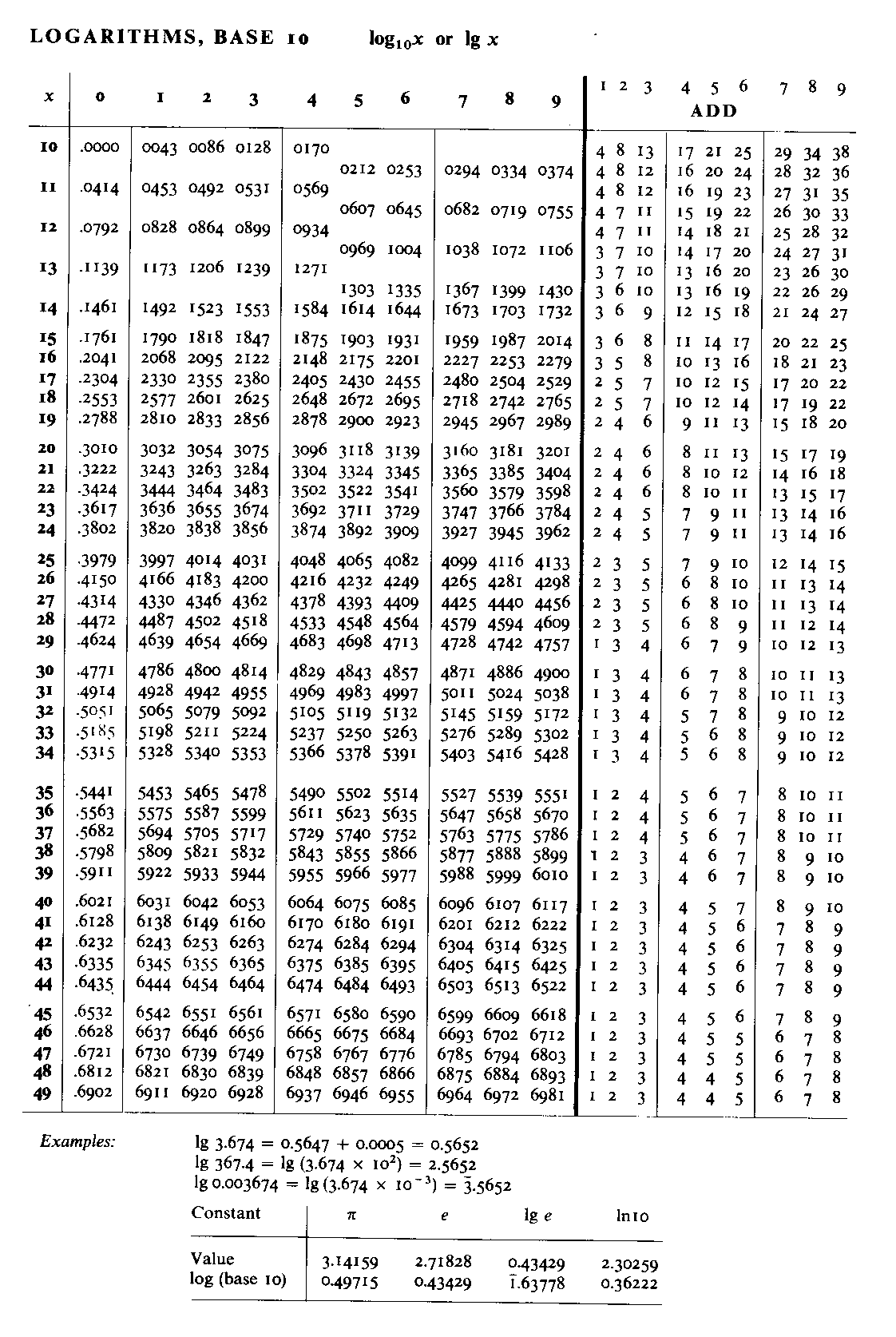
The log tables Use of Logs and AntilogsUse Of Common LogsCommon Logarithms are powers to the base 10. Natural logs are exponents to the base "e". "e" = 2.71 In working with common logs the following procedure is followed:
The difficult part is step 2. You have to have a log table to get it. Lets assume that you have a 4-place log table. Here is how you would determine the log. Let's say you wanted to know the log of 4.18. In the log table there will be rows of four digit numbers. Each row will be labeled at the extreme left of the row with a two digit numbers separated by a decimal. Then there will be columns of four digit numbers each c olumn headed by a single digit from 0-9. Each of the four digit numbers in the table has a decimal to the left most digit which does not show but should be placed in there. So if we want the log of 4.18, we would go to the left most end of the rows and go down until you reach the row labeled with 4.1. We would move to the right in this row. Then we would go to the top of the columns and move over to the column labeled with an 8. We would then proceed downward in that column. If you extend from the 4.1 across to the right and extend from the top of the column marked 8 downward until the two extensions intersect, at the point of intersection will be a four digit number actually called the mantissa of the final log determination. To the left of this four digit number will be a decimal or one should be placed there. Let me take an example from the beginning: Let's determine the log 25,600
Negative LogsIt is possible to have negative logs as well. For example, what would be the log of 0.00314.
Often they leave negative logs in the first form that is .4969 -3 Calculation Using LogsYou can calculate with logs in the following manner Multiplication of numbersTo multiply numbers using logs simply:
Division of Numbers
Raising A Number To A Power
The last step in all the above computations using logs involves knowing how to determine the antilog of a logarithm. This is easy if the log is positive. Determining the Antilog of a positive log form
Let's take an example: Antilog of 3.8734
Determining the Antilog Of A Negative LogDetermining antilogs of negative log forms can be a bit tricky since a Negative log form has a negative mantissa. All of the mantissas in the 4 place log table are positive mantissas so one has to take the additional step of converting the negative log to a form that has a positive mantissa. For example: Antilog of -4.5611
More examples using log tablesMultiplication using log tablesLet's multiply 4138 by 567. (Remember, we used Napier's roads to calculate the product so we know the result 2346246):
Comparing to the exact result we got using the Napier's bones (2346246) we are pretty close. The error is: 100 × (2346246 - 2346000)/2346246 = 0.01% 100 × 246/2346246 = 0.01% Division using log tablesThe good news we can also divide numbers using log tables. For example : log10(4138 : 567) = log10(4138)- log(567): 3.6167 - 2.7536 0.8631 The antilog of 0.8631 is 7.296 or 7.297. So 4138 : 567 = 7.297. The square root of 2 using log tablesThe square root of two is 2½. The log10(2½)=½×log10(2.0)= ½×0.3010 = 0.1550. So the square root of 2 is the antilog of 0.1550 = 1.414The cube root of 2 using log tablesThe cube root of two is 21/3;. The log10(21/3)=log10(2.0):3= 0.3010 : 3= 0.100(3). So the cube root of 2 is the antilog of 0.1004 = 1.26The Logarithmic Scale
Picture of a 2 foot Gunter scale. The yellow spots are brass inserts to provide wear resistance at commonly used points.
William Oughtred lived from 1574 to 1660 Soon afterwards Gunter introduced his rule, in 1622, William Oughtred simplified things further by taking two Gunter's lines and sliding them relative to each other thus eliminating the dividers. 
He noticed that there is a easyer way to add distances than using a divider. To measure the length of a segment of right-hand side we normally use a scale either in cm, or in milimeters. If we have 2 identical rules we can use them to make additions and subtractions. It will be admitted that each division line in mm corresponds to a number. 
For example, to add 34 + 48 = 82 we lay out the 2 rules one against the other as indicated in in the figure. We place the division 0 of the rule C above division 34 of rule D. It results the division 48 of the rule C is placed opposite to dvision 82 of rule D. 82 represents the sum we are looking for.
Based on this observation, Oughtred was the first to see that a simpler and more sophisticated method of multiplication and division could be achieved by placing two logarithmic rules side by side and using the position of the numbers relative to each other to calculate the desired results. 
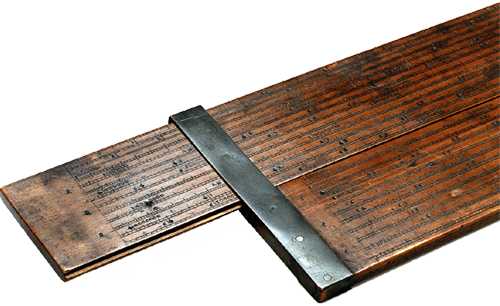
The first slide rule | |||||||||||||||||||||||||
| Use the mouse to darg the rules and the cursor to perform some calculations. For example drag the upper rule and align the division 1 (on the left of the upper rule) over the division 2 on the bottom rule (be careful to not place it by mistake over the division 1 2). Next drag the red hair cursor to align over the division 3 on the upper rule and read the result under the cursor on the bottom rule. It must be 6. This way we calculated 2◊3=6. Next let the cursor as is, positioned over division 6 on the bottom rule and drag the upper rule until its division 4 is aligned under the red hair cursor (being this way also aligned over the division 6 on the bottom rule). Now read on the buttom rule the value pointed by the division 1 on the upper rule. This should be 1 5. This way we divided 6 by 4 obtaining the result 1.5. (6 ÷ 4 = 1.5). Actually the result we obtained was 1 5 not 1.5 | |
 |
Placing the decimal point is our responsability, depending the operands values. We would obtain the same 1 5 result not only dividing 6 by 4 but also .6 by 4, 60 by 4 and 600 by 4, etc. But 0.6 ÷ 4 = 0.15, 60 ÷ 4 = 15.0 and 600 ÷ 4 = 150.0.The slide rule doesn't have a clue what is the magnitude of the operands. It gives us only the result digits and is up to the slide rule operator to decide where to place the decimal point depending on the the operands values. |

|
|
Oughtred's most important work, Clavis Mathematicae (1631), included a description of Hindu-Arabic notation and decimal fractions and a considerable section on algebra. He experimented with many new symbols including the "◊" symbolfor multiplication and :: for proportion as well as the abbreviations "sin" and "cos" for the sine and cosine functions.. Like all Oughtred's works it was very condensed containing only 88 pages. He also developed the circular slide rule, which operated in the same fashion as a linear slide rule, except that it makes use of an inner and an outer ring Oughtred published his renowned work Circles of Proportion and the Horizontal Instrument in 1632. 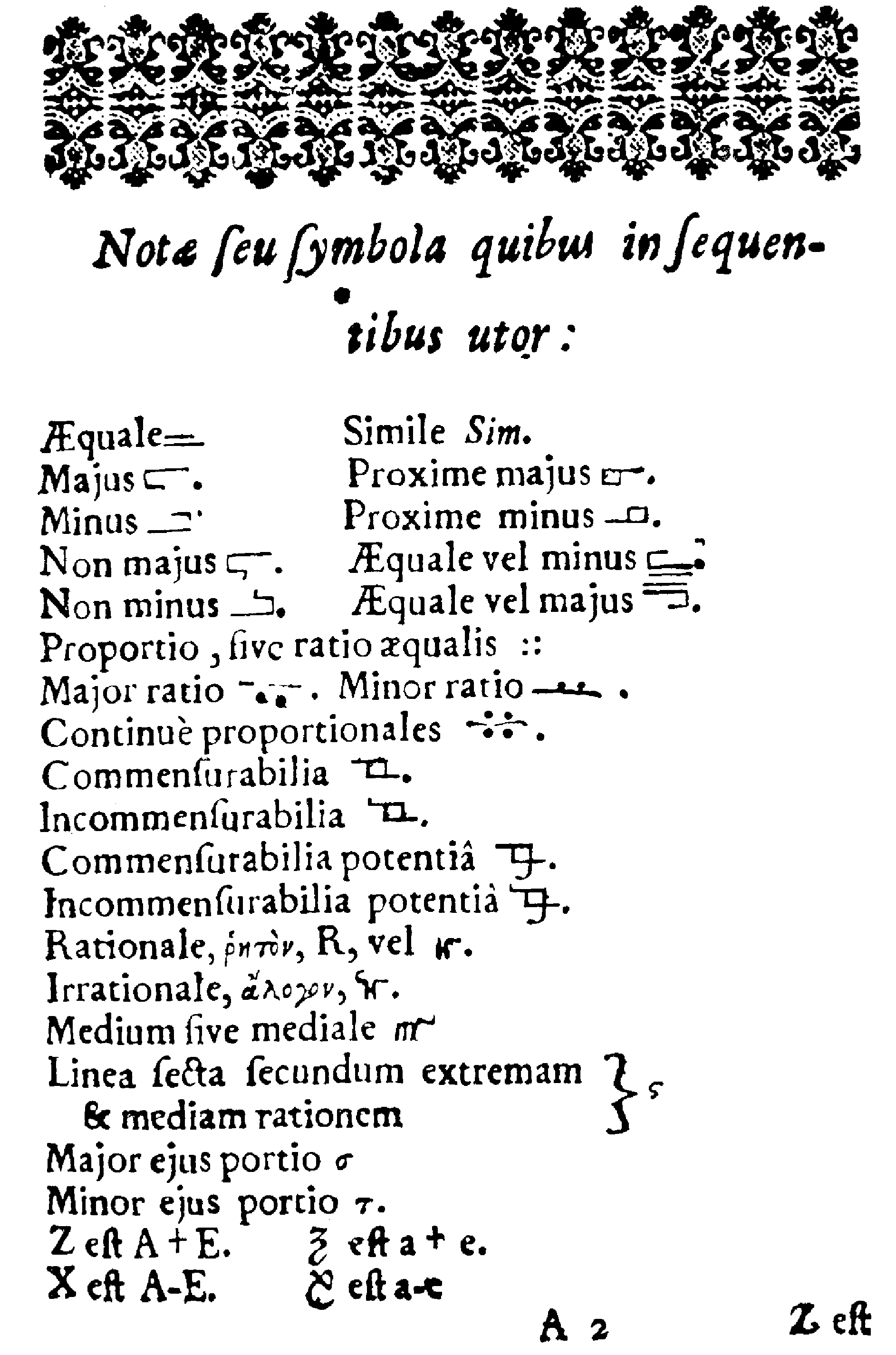
Slide Rules
Slide rules |